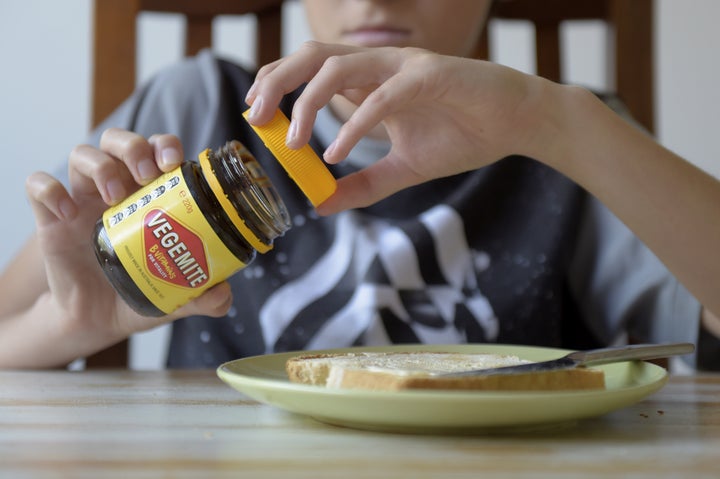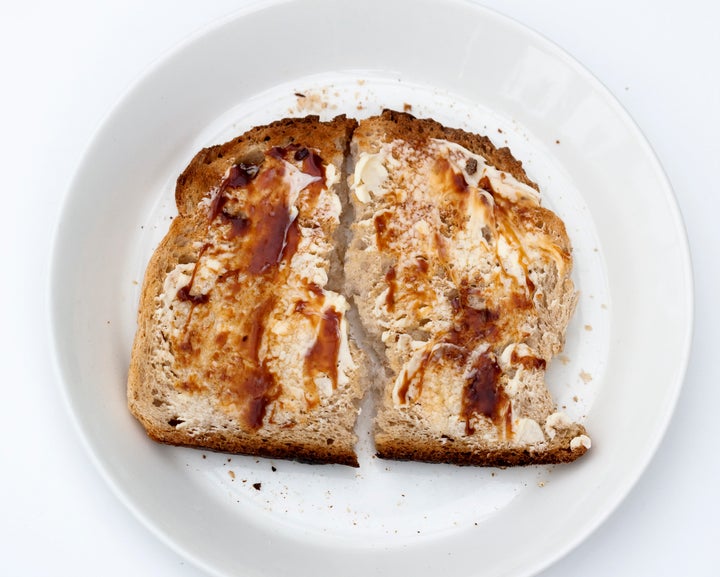
First, I want to thank you for being open-minded, America. I know most of you think Vegemite, known as a pantry pariah everywhere except in Australia, is nasty stuff.
But I’m not suggesting you eat Vegemite, adult Americans. It’s too late for you. The salty black condiment, a concentrated yeast extract spread sparingly on bread with butter, cheese or avocado, is an acquired taste, like fermented fish in Sweden. Vegemite can be foul-tasting to the uninitiated — Barack Obama said it was “horrible.”
Instead, I’m suggesting you make your kids Vegemite sandwiches, and as soon as they start eating solids. Because Vegemite — salty, savory, umami, pleasurable only in small amounts — is the antithesis of sugar, the saccharine, addictive, can’t-get-enough product we are, conveniently for junk food giants, hard-wired to get hooked on.
I’ll go as far as saying eating a Vegemite sandwich is like giving the middle finger to Big Sugar — which, as Gary Taubes writes in The Case Against Sugar, has paid scientists and lobbied the government to downplay its negative effects. Consuming too much added sugar is directly linked to obesity, high blood pressure, chronic inflammation, diabetes, heart disease and some cancers.
It’s a radical idea, I know. But in a world hooked on sugar, where food product companies add it to everything from bread to pasta sauce to profit off our evolutionary addiction to the sweet stuff, perhaps something radical is required.
Children’s Taste Preferences: Nature vs. Nurture
“Biologically, children are predisposed to overconsume all that is sweet,” Dr. Julie Mennella, a biopsychologist specializing in the development of food and flavor preferences in humans at the Monell Chemical Senses Center in Philadelphia, said.
Research has shown a preference for sweet foods is heightened during childhood, before decreasing in mid-adolescence as a teenager’s rate of growth slows down. Thousands of years ago, a child’s appetite for sweet-tasting fruit would have helped it to develop, grow healthy and survive. But today, we live in a wildly different world.
“Humans didn’t evolve in an environment with inexpensive, easily accessible sweet-tasting foods or artificial sweeteners and other sugar substitutes,” Mennella said. ”Children are particularly vulnerable in this food environment.”

Little can be done about the evolutionary appetite for all things sweet, and it should be made clear that eating less sugar or sweet foods as a child doesn’t mean a person is less likely to eat sweet foods as an adult (it’s possible, but there have been no long-term studies done to look at this).
However, early-life food experiences do influence a child’s palate and how they think things should taste as they grow up.
In a study by Mennella and co-author Gary K. Beauchamp, healthy infants were divided into three groups: the first drank one brand of hydrolysate (non-dairy) formula, the second drank a different brand of hydrolysate formula, while a third group was made up of babies who were given a milk-based formula by their parents.
When the group of babies who had never consumed hydrolysate formula were given some to try, they rejected it and drank very little. Infants who’d been drinking a particular brand of hydrolysate formula had the same reaction when they were given the other brand, and this taste preference remained until much later in childhood.
“Although this type of formula [hydrolysate] is extremely unpalatable to older children and adults because of its offensive flavor, infants four months of age or younger accept it without difficulty,” Mennella wrote in the study. “If infants receive exposure by the third month of life, they continue to accept these formulas for a considerable period of time thereafter.”
Feed your baby Vegemite and they will most likely gobble it up like a PB&J, while a non-Australian adult’s reaction will probably be more like the people in this video.
Vegemite vs. Peanut Butter: A Comparison
Giving your kid a Vegemite sandwich isn’t just a good way to encourage them to be an adventurous eater, broaden their palate and stick it to Big Sugar. It’s nutritious.
“A Vegemite sandwich made with whole grain bread and cheese or avocado is a great healthy option,” Mary Cluskey, associate professor of nutrition at Oregon State University, told HuffPost. “A much healthier option than a peanut butter and jelly sandwich.”
Peanut butter has, on average, nine grams of sugar per 100 grams, while Vegemite has just over two.

“As well as the whole grains, there’s healthy fats and calcium. It’s also a great source of a few minerals and several B vitamins, especially thiamine and folic acid.”
“When equal quantities of peanut butter and Vegemite are compared, peanut butter does not have as much of the B vitamins (thiamin, niacin, riboflavin, pyridoxine),” Clusky said.
“However, peanut butter has higher levels of vitamin E — which is harder to get from the average diet than the B vitamins — and iron, phosphorus, magnesium and zinc. Peanut butter is higher in fat, but they are about the same for protein and carbs.”
Clusky pointed out that Vegemite is higher in sodium than peanut butter, although it’s not much of a concern given the small serving size (except for adults on a low-sodium diet).
Vegemite is a naturally nut-free product, making it a good option for children who have peanut allergies or go to a school where nuts have been banned.
It’s also vegan, and does not come into contact with any animal products during production. Vegemite is certified kosher (by Kosher Australia) and certified halal by The Australian Federation of Islamic Councils.
By making Vegemite sandwiches a normal part of a child’s diet, they’ll have a cheap, fast, nutritious, filling and low-sugar go-to meal to reach for, for the rest of their lives.
Thankfully, you don’t have to go to Australia or bribe an Aussie to handover one of their precious jars of Vegemite. It’s unlikely you’ll find Vegemite in the condiments section in American supermarkets, but it has been seen in the international section or grouped with soup stocks.
Alternatively, it is on Amazon — Amazon Prime can have a jar to you in two days.
Still, it’s hard to imagine that America would embrace Vegemite. Family and culture influence our taste preferences. One reason Australians eat Vegemite is because as children, they sit around a table with our parents who are eating it, too.
It’s also become a pantry staple, no doubt, thanks to the benefits for busy and budget-conscious parents. One 560-gram jar provides at least 112 sandwiches. Parents can slap a couple of Vegemite sandwiches together and know they’re giving their children a healthy lunch.
Vegemite is also a source of national pride. An Australian-made product the rest of the world finds weird, it gives a sense of identity to those who eat it and love it.
If Americans refuse to eat Vegemite sandwiches, it’s understandable. But the concept of what Vegemite represents could be an inspiring way to change our eating habits. Salty black stuff on bread ― it shouldn’t work, but it does (according to about 24 million people on the other side of the world, anyway). It opens up the possibilities of what a sandwich can be. It pushes the boundaries. It’s adventurous. It’s open-minded. Which, with rising obesity rates, an ever-diversifying population and potential global food sustainability issues brought on by population growth and climate change-induced conditions, is what we need the next generation to be.
If you decide to try Vegemite, you’ll need to know how to prepare it in a sandwich.
How To Make A Vegemite Sandwich
1. You only need a very small amount — about half a teaspoon or less ― of Vegemite spread evenly across one piece of bread.
2. Choose the right bread. Vegemite will taste funny on bread that has more than the bare minimum of added sugar or bread with honey in it. Find bread that’s as close to sourdough as possible, with an ingredients list that has not much more on it than yeast, flour, salt and water.
3. Before you put on the Vegemite, spread a small amount of butter or margarine on the bread; this helps it to spread easier and taste creamier.
4. Add a slice of cheese or a serving of avocado. It makes a Vegemite sandwich taste even better, and also ups the nutritional value.